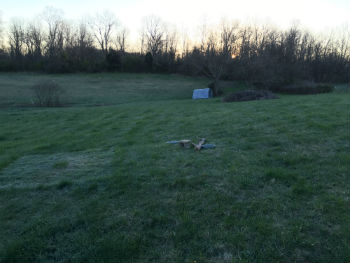Batch #2 of our incubated chicks has been terribly unlucky. We started with thirteen, and to our surprise, only three turned out to be roosters (it’s usually a 50/50 split). All seemed to be going well, but then seven (including six hens) died two weeks ago. After surviving that, the remaining six should be charmed…but that doesn’t seem to be the case.
 Yesterday, we had high winds here, which happen from time to time. What we didn’t expect was for the winds to be so strong, they would actually lift the chicken tractor and blow it down the hill. With six 7 week old chicks in it.
Yesterday, we had high winds here, which happen from time to time. What we didn’t expect was for the winds to be so strong, they would actually lift the chicken tractor and blow it down the hill. With six 7 week old chicks in it.
The tractor is built from PVC pipe, wood, and hardware cloth, with a tarp over the top to provide shade and rain protection. It’s heavy enough that it requires two reasonably strong adults to move it. We’ve used this same design previously, and the winds, even high winds, have merely blown through it. Something was different yesterday – the wind seemed to be coming from all directions. Unbelievably, it had actually moved the tractor about 100′ from its original location, and broken some of the PVC supports.
When we realized what had happened, we ran out, dread-filled, to collect the chicks. We found four of them huddled in the grass, in groups of two. Further down the hill, we found a single Australorp cross hen, and we could immediately tell that she was badly injured. When we got to the tractor, a Gold-Laced Wyandotte cross roo was still inside, lying down. He seemed to be favoring a leg, but didn’t otherwise have visible injuries.
Back at the brooder, we closely examined each chick as we put them in. Four looked uninjured. The little roo was having trouble standing, but we couldn’t determine the extent of the leg problem. With luck, it’ll turn out to be a minor injury and he’ll recover quickly.
The injured hen wasn’t as fortunate. She had suffered a wound that degloved her breast from her wing to nearly her tail on one side. It was a gory sight, but she was a trooper and calmly let us handle her. We cleaned the wound as gently as possible, spread antibiotic ointment on it, and wrapped the extensive wound in gauze. We also put her in a crate by herself with electrolyte water and food.
Both of the injured chicks survived the night, clearing one hurdle. Today, the little roo is still limping but able to stand, so he seems to be improving. He’s eating and drinking normally, too.
We removed the gauze dressing from the hen’s wound and while still raw-looking, it appears to be healing. We sprayed the area liberally with a non-toxic wound care product that cleanses and promotes healing and placed her back in the isolation crate. She seems to be alert but understandably uncomfortable, and is eating, drinking, and pooping. We’ll keep spraying the wound, leave it uncovered, and keep an eye on it to ensure it doesn’t become infected. The Australorp crosses are tough birds, so if it’s possible to survive, we believe she will.
It’s calm, sunny, and there’s barely a breeze today. Yesterday almost seems like a figment of the imagination, but the casualties are an inescapable reminder that the dangerous winds really did happen. Now we get to work on making sure this doesn’t happen again…and that likely includes dismantling the damaged tractor and building a better one. We can’t fight nature, but we can continually improve so that these incidents are minimized or, ideally, prevented.
